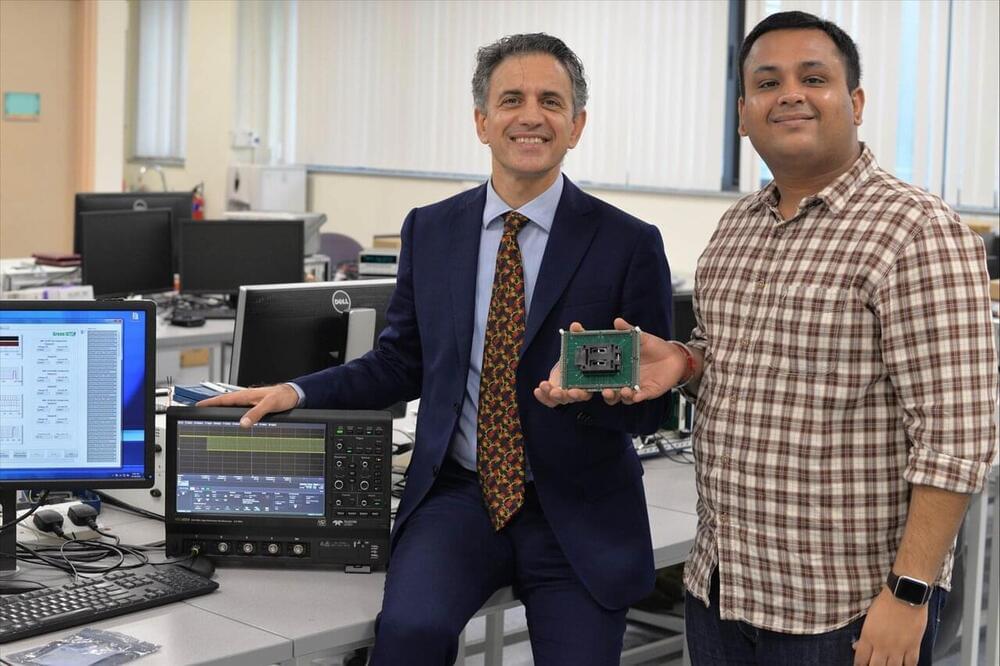Synchron has implanted its BCI in a US patient for the first time—bringing it a big step closer to distribution.



‘Tis all in the senses.
On her blog, Lepht Anonym describes herself as “a faceless, genderless British biohacker. It lacks both gods and money and likes people, science, and practical transhumanism.” Anonym practices, sometimes referred to as grinding — a subculture of biohacking — DIY surgery to insert electronic hardware under the skin.
At the Grinderfest in 2019, Anonym inserted a little “pirate box” device in her upper right arm.
The Grindfest\
In conversation with Lepht Anonym, a faceless, genderless British biohacker that has implanted over 50 magnets and chips in her body for sensory ‘kicks’.
Tech giants including Alphabet and IBM are racing toward building a quantum computer, and financial firms including JPMorgan are exploring possible uses.

Entanglement is an ubiquitous concept in modern physics research: it occurs in subjects ranging from quantum gravity to quantum computing. In a publication that appeared in Physical Review Letters last week, UvA-IoP physicist Michael Walter and his collaborator Sepehr Nezami shed new light on the properties of quantum entanglement—in particular, for cases in which many particles are involved.
In the quantum world, physical phenomena occur that we never observe in our large scale everyday world. One of these phenomena is quantum entanglement, where two or more quantum systems share certain properties in a way that affects measurements on the systems. The famous example is that of two electrons that can be entangled in such a way that—even when taken very far apart—they can be observed to spin in the same direction, say clockwise or counterclockwise, despite the fact that the spinning direction of neither of the individual electrons can be predicted beforehand.

Smartphone ownership (85%) and home broadband subscriptions (77%) have increased among American adults since 2019 – from 81% and 73% respectively. Though modest, both increases are statistically significant and come at a time when a majority of Americans say the internet has been important to them personally. And 91% of adults report having at least one of these technologies.
A Pew Research Center survey of U.S. adults conducted from Jan. 25 to Feb. 8, 2021, also finds that some Americans have difficulties when trying to go online. Some 30% of adults say they often or sometimes experience problems connecting to the internet at home, including 9% who say such problems happen often. Still, a majority of Americans say these connection troubles occur rarely (41%) or never (21%).
While there has been slight growth in the share who say they subscribe to high-speed internet, about a quarter of the population still does not have a broadband internet connection at home. And broadband non-adopters continue to cite financial constraints as one of the most important reasons why they forgo these services. Among non-broadband users, 45% say a reason why they do not have broadband at home is that the monthly cost of a home broadband subscription is too expensive, while about four-in-ten (37%) say the same about the cost of a computer. Beyond cost barriers, a little fewer than half of non-users cite having other options for internet access or the fact that their smartphone does everything online they need as a reason why they do not have a high-speed internet connection at home.
What’s the best way to get 3D characters in videogames to look real and expressive? Two computer scientists at Université de Montréal have come up with answer: use simple bitmap sketches to make their poses more lifelike.
Assistant professor Mikhail Bessmeltsev and his Ph.D. student Kirill Brodt have developed an animation tool that uses drawings to control how videogame characters stand and move in three dimensions.
The duo’s study is published on July 22 in ACM Transactions on Graphics. We asked them to tell us more.
I promise you: this post is going to tell a scientifically coherent story that involves all five topics listed in the title. Not one can be omitted.
My story starts with a Zoom talk that the one and only Lenny Susskind delivered for the Simons Institute for Theory of Computing back in May. There followed a panel discussion involving Lenny, Edward Witten, Geoffrey Penington, Umesh Vazirani, and your humble shtetlmaster.
Lenny’s talk led up to a gedankenexperiment involving an observer, Alice, who bravely jumps into a specially-prepared black hole, in order to see the answer to a certain computational problem in her final seconds before being ripped to shreds near the singularity. Drawing on earlier work by Bouland, Fefferman, and Vazirani, Lenny speculated that the computational problem could be exponentially hard even for a (standard) quantum computer. Despite this, Lenny repeatedly insisted—indeed, he asked me again to stress here—that he was not claiming to violate the Quantum Extended Church-Turing Thesis (QECTT), the statement th at all of nature can be efficiently simulated by a standard quantum computer. Instead, he was simply investigating how the QECTT needs to be formulated in order to be a true statement.
Dr. Amber Salzman, Ph.D. is Chief Executive Officer and Director of Epic Bio (https://epic-bio.com/), a fascinating therapeutic epigenome editing startup, developing therapies to modulate gene expression at the level of the epigenome, which just recently emerged from stealth mode with a $55 million funding round.
Dr. Salzman has more than 30 years of experience in the pharmaceuticals industry. Before joining Epic Bio, Dr. Salzman served as the president and CEO of Ohana Biosciences, pioneering the industry’s first sperm biology platform. Before Ohana, she served as the president and CEO of Adverum Biotechnologies and was a co-founder of Annapurna, SAS, where she served as President and CEO before its merger with Avalanche Biotechnologies to become Adverum. In that role, she saw the company’s stock price double.
Dr. Salzman began her career as a member of the GlaxoSmithKline (GSK) research and development executive team, where she was responsible for operations in drug development across multiple therapeutic areas, overseeing global clinical trials with over 30,000 enrolled patients, managing 1,600 employees and a $1.25B budget.
Following her time at GSK, Dr. Salzman served as the CEO of Cardiokine, a pharmaceutical company that developed treatments for the prevention of cardiovascular diseases and saw the successful sale of the company to Cornerstone Therapeutics.
Dr. Salzman currently serves on the Osler Diagnostics (UK) and AviadoBio (UK) Boards.
Dr. Salzman received her bachelor’s degree from Temple University in computer science and holds a Ph.D. in mathematics from Bryn Mawr College.

A team of researchers from the National University of Singapore (NUS) has developed a novel technique that allows Physically Unclonable Functions (PUFs) to produce more secure, unique ‘fingerprint’ outputs at a very low cost. This achievement enhances the level of hardware security even in low-end systems on chips.
Traditionally, PUFs are embedded in several commercial chips to uniquely distinguish one silicon chip from another by generating a secret key, similar to an individual fingerprint. Such a technology prevents hardware piracy, chip counterfeiting and physical attacks.
The research team from the Department of Electrical and Computer Engineering at the NUS Faculty of Engineering has taken silicon chip fingerprinting to the next level with two significant improvements: firstly, making PUFs self-healing; and secondly, enabling them to self-conceal.
